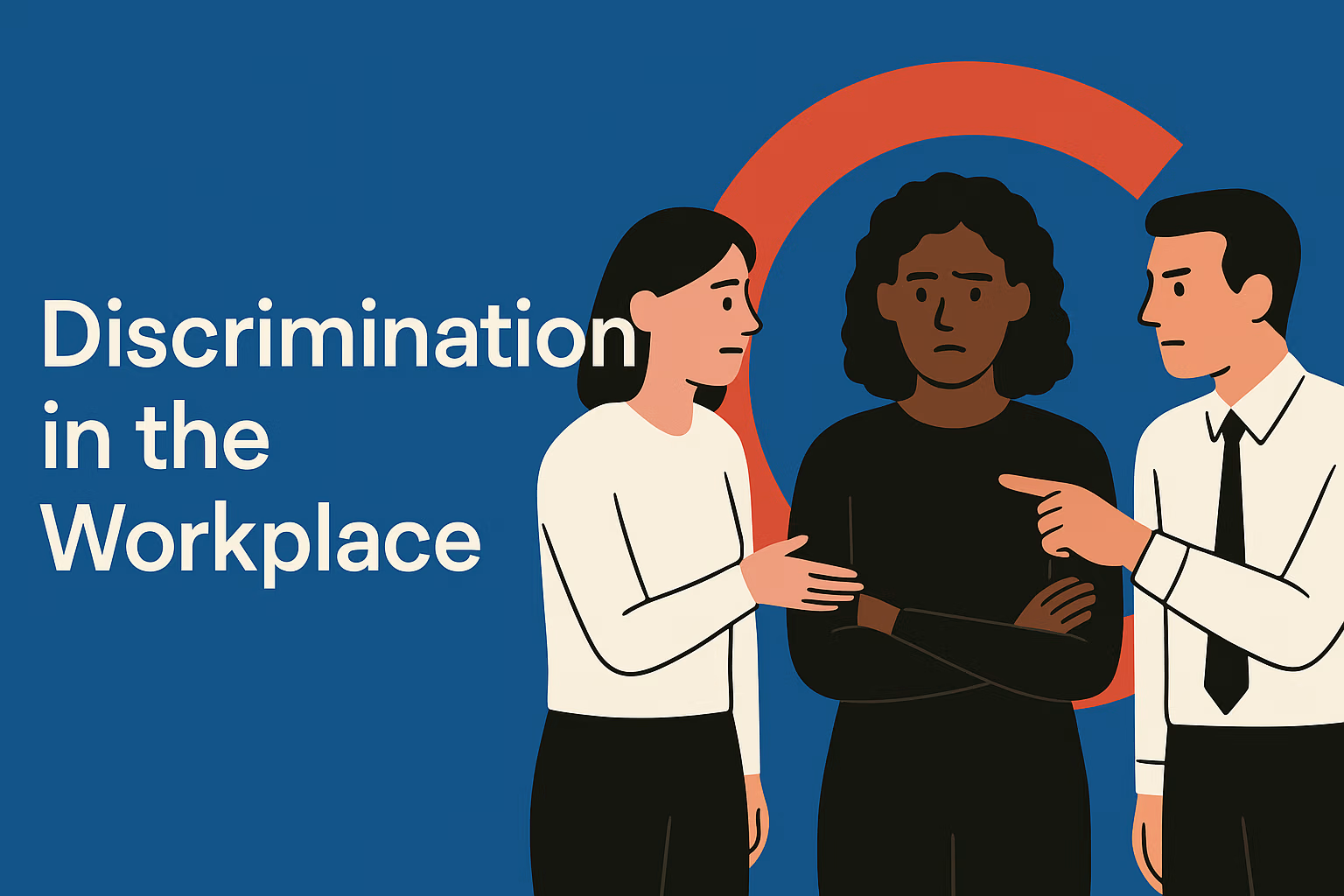What Is Discrimination in the Workplace? (And Why It Still Happens)

Discrimination in the workplace affects millions of employees every year — and while some forms are obvious, many are subtle, systemic, or disguised as “business decisions.” Whether you’re just starting your career or you’ve been in the workforce for decades, it’s important to recognize what workplace discrimination looks like, who it affects, and why it’s still so pervasive today.
📌 What Is Workplace Discrimination?
Workplace discrimination occurs when an employee or job applicant is treated unfairly or unequally because of specific characteristics that are protected by law.
Under U.S. federal law these protected characteristics include:
- Race or color
- Religion
- Sex (including pregnancy, sexual orientation, gender identity)
- National origin
- Age (40 or older)
- Disability (physical or mental)
- Genetic information
Other state and local laws offer even broader protections, such as the District of Columbia Human Rights Act (DCHRA) and the New York State Human Rights Law (NYSHRL)
Workplace discrimination can occur in nearly every aspect of employment:
| Stage | Examples of Discrimination |
|---|---|
| Hiring | Skipping over qualified candidates based on ethnicity or age |
| Promotions | Favoring employees of a certain gender or race |
| Pay & Benefits | Paying women or disabled employees less than others |
| Discipline | Targeting certain employees for write-ups or demotions |
| Termination | Firing someone shortly after a disability disclosure |
🧠 Not All Discrimination Is Obvious
It’s easy to think of discrimination as overt — like using racial slurs or firing someone because they’re pregnant. But in reality, discrimination often hides behind vague justifications:
- “They’re just not the right fit.”
- “We want someone more dynamic.”
- “We’re restructuring the department.”
While those phrases might seem neutral, they can mask biases when used selectively against certain groups.
⚠️ Key Warning Signs:
- Patterns where one group is consistently overlooked or excluded
- Sudden negative treatment after disclosing a protected trait (e.g., pregnancy, disability)
- Coded language in feedback (e.g., “too aggressive” or “too sensitive” — often gendered or racialized)
🎯 Legal Definition: What Counts as Discrimination?
According to the U.S. Equal Employment Opportunity Commission (EEOC): Discrimination involves treating someone unfavorably because of a protected trait in any aspect of employment — hiring, firing, pay, job assignments, promotions, layoff, training, benefits, or any other term or condition of employment.
In short, if your identity, not your performance, is the reason for differential treatment, you may be facing illegal discrimination.
🔍 Types of Discrimination in the Workplace
Discrimination can take multiple forms, and they’re not always easy to identify:
Direct Discrimination
Explicit unfavorable treatment based on a protected trait.
Example: A hiring manager says, “We don’t want to bring in someone your age — we need new energy.”
Indirect Discrimination
A company policy or rule appears neutral but disproportionately affects certain groups.
Example: A “must work Sundays” policy may negatively impact religious employees who observe Sabbath on Sunday.
Systemic Discrimination
Patterns, policies, or cultures that unfairly benefit one group while disadvantaging others.
Example: A firm that recruits only from certain colleges may exclude candidates of color or low-income backgrounds.
Harassment (as a form of discrimination)
Persistent unwelcome conduct based on a protected trait that creates a hostile work environment.
Example: Jokes about someone’s gender identity or ethnic background that make them feel unsafe or isolated.
🧮 Real-World Stats That Prove It’s Still Happening
Workplace discrimination is far from solved. Here are some sobering stats:
| Fact | Source |
|---|---|
| Over 73,000 discrimination charges were filed with the EEOC in 2022 | EEOC.gov |
| 61% of employees report witnessing or experiencing bias at work | Glassdoor Survey, 2023 |
| Women earn about 82 cents for every dollar earned by men — and the gap is wider for women of color | U.S. Census Bureau, 2023 |
| Workers over 50 are more likely to be laid off and less likely to be rehired | AARP |
🧑💼 Fictional Case Study: Subtle Racial Discrimination
“Ryan” is a Black marketing analyst with excellent performance metrics and three years of experience at his firm. He applies for a team lead role but doesn’t get it — despite being the most qualified applicant. The position goes to a less experienced white colleague. Ryan’s manager says the other employee is a “better cultural fit.”
Soon after, Ryan notices he’s left off meeting invites and major project planning sessions. While no one uses racist language, the pattern is clear.
This is an example of covert, systemic racial discrimination, and it’s sadly common.
🧠 Why Discrimination Still Happens in 2025
Even with laws in place, workplace discrimination remains widespread. Here’s why:
1. Unconscious Bias
Many decisions are shaped by internalized stereotypes that people don’t even realize they hold.
2. Cultural Norms
Some industries still operate with outdated assumptions — e.g., “Women aren’t aggressive enough for sales.”
3. Lack of Accountability
Companies may ignore or excuse discriminatory behavior to avoid conflict or legal exposure.
4. Retaliation Fears
Many victims of discrimination stay silent because they fear losing their job or professional reputation.
💬 Quote to Reflect On
“The absence of overt prejudice does not mean the absence of discrimination.”
— Angela Davis
🔗 What’s Next?
In the next post in this series, we’ll break down:
👉 How to Recognize Discrimination at Work and Build a Paper Trail
From subtle slights to unequal treatment, we’ll show you how to identify and document bias with clarity and confidence.
📘 TL;DR – Key Takeaways
- Discrimination in the workplace happens when you’re treated unfairly based on protected traits like race, gender, age, or disability.
- It can be overt or subtle, but it’s always harmful.
- Federal law protects you, and it’s still widespread despite progress.
- Recognizing and understanding discrimination is the first step toward justice.
Stay Updated
Get the latest updates about workplace rights and our app launch.